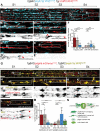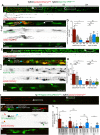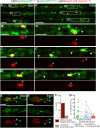Regenerating vascular mural cells in zebrafish fin blood vessels are not derived from pre-existing mural cells and differentially require Pdgfrb signalling for their development
- PMID: 35297968
- PMCID: PMC9058498
- DOI: 10.1242/dev.199640
Regenerating vascular mural cells in zebrafish fin blood vessels are not derived from pre-existing mural cells and differentially require Pdgfrb signalling for their development
Abstract
Vascular networks comprise endothelial cells and mural cells, which include pericytes and smooth muscle cells. To elucidate the mechanisms controlling mural cell recruitment during development and tissue regeneration, we studied zebrafish caudal fin arteries. Mural cells colonizing arteries proximal to the body wrapped around them, whereas those in more distal regions extended protrusions along the proximo-distal vascular axis. Both cell populations expressed platelet-derived growth factor receptor β (pdgfrb) and the smooth muscle cell marker myosin heavy chain 11a (myh11a). Most wrapping cells in proximal locations additionally expressed actin alpha2, smooth muscle (acta2). Loss of Pdgfrb signalling specifically decreased mural cell numbers at the vascular front. Using lineage tracing, we demonstrate that precursor cells located in periarterial regions and expressing Pgdfrb can give rise to mural cells. Studying tissue regeneration, we did not find evidence that newly formed mural cells were derived from pre-existing cells. Together, our findings reveal conserved roles for Pdgfrb signalling in development and regeneration, and suggest a limited capacity of mural cells to self-renew or contribute to other cell types during tissue regeneration.
Keywords: Blood vessel; Caudal fin; Mural cell; Pdgfrb signalling; Tissue regeneration; Zebrafish.
© 2022. Published by The Company of Biologists Ltd.
Conflict of interest statement
Competing interests The authors declare no competing or financial interests.
Figures









Similar articles
-
Conserved and context-dependent roles for pdgfrb signaling during zebrafish vascular mural cell development.Dev Biol. 2021 Nov;479:11-22. doi: 10.1016/j.ydbio.2021.06.010. Epub 2021 Jul 24. Dev Biol. 2021. PMID: 34310924 Free PMC article.
-
Heterogeneous pdgfrb+ cells regulate coronary vessel development and revascularization during heart regeneration.Development. 2022 Feb 15;149(4):dev199752. doi: 10.1242/dev.199752. Epub 2022 Feb 25. Development. 2022. PMID: 35088848 Free PMC article.
-
Identification of distinct vascular mural cell populations during zebrafish embryonic development.Dev Dyn. 2024 May;253(5):519-541. doi: 10.1002/dvdy.681. Epub 2023 Dec 19. Dev Dyn. 2024. PMID: 38112237 Free PMC article.
-
Pericyte Biology in Zebrafish.Adv Exp Med Biol. 2018;1109:33-51. doi: 10.1007/978-3-030-02601-1_4. Adv Exp Med Biol. 2018. PMID: 30523588 Review.
-
Regulation of signaling interactions and receptor endocytosis in growing blood vessels.Cell Adh Migr. 2014;8(4):366-77. doi: 10.4161/19336918.2014.970010. Cell Adh Migr. 2014. PMID: 25482636 Free PMC article. Review.
Cited by
-
Origins of Aortic Coarctation: A Vascular Smooth Muscle Compartment Boundary Model.J Dev Biol. 2025 Apr 18;13(2):13. doi: 10.3390/jdb13020013. J Dev Biol. 2025. PMID: 40265371 Free PMC article.
-
Single-cell analysis reveals distinct fibroblast plasticity during tenocyte regeneration in zebrafish.Sci Adv. 2023 Nov 17;9(46):eadi5771. doi: 10.1126/sciadv.adi5771. Epub 2023 Nov 15. Sci Adv. 2023. PMID: 37967180 Free PMC article.
-
Biology of vascular mural cells.Development. 2023 Aug 15;150(16):dev200271. doi: 10.1242/dev.200271. Epub 2023 Aug 28. Development. 2023. PMID: 37642459 Free PMC article. Review.
-
Endothelial cell Piezo1 promotes vascular smooth muscle cell differentiation on large arteries.bioRxiv [Preprint]. 2024 Jun 12:2024.06.11.598539. doi: 10.1101/2024.06.11.598539. bioRxiv. 2024. Update in: Eur J Cell Biol. 2025 Mar;104(1):151473. doi: 10.1016/j.ejcb.2024.151473. PMID: 38915529 Free PMC article. Updated. Preprint.
-
Endothelial cell Piezo1 promotes vascular smooth muscle cell differentiation on large arteries.Eur J Cell Biol. 2025 Mar;104(1):151473. doi: 10.1016/j.ejcb.2024.151473. Epub 2024 Dec 20. Eur J Cell Biol. 2025. PMID: 39729736
References
-
- Ando, K., Shih, Y.-H., Ebarasi, L., Grosse, A., Portman, D., Chiba, A., Mattonet, K., Gerri, C., Stainier, D. Y. R., Mochizuki, N.et al. (2021). Conserved and context-dependent roles for pdgfrb signaling during zebrafish vascular mural cell development. Dev. Biol. 479, 11-22. 10.1016/j.ydbio.2021.06.010 - DOI - PMC - PubMed
Publication types
MeSH terms
Substances
Grants and funding
LinkOut - more resources
Full Text Sources
Molecular Biology Databases
Research Materials
Miscellaneous

